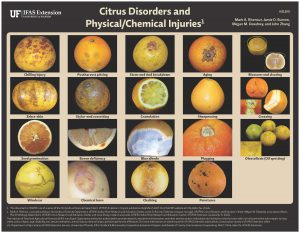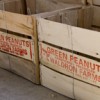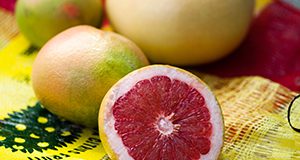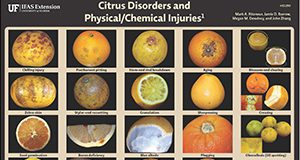Current citrus production practices often include the use of various chemicals, many of which are pesticides. Chemical residues on the fruit after harvest are a concern to regulators and the public alike because of their potential negative health effects. Therefore, the US and other countries set maximum residue limits (MRLs) on fresh produce for various chemicals. This five-page document is part of the 2017-2018 Florida Citrus Production Guide and discusses the MRLs for various chemicals used on Florida citrus. Written by Mark Ritenour and published by UF’s Horticultural Sciences Department, October 2017.
http://edis.ifas.ufl.edu/hs1301
Tag: Mark Ritenour
Citrus Fruit Blemishes and Decay Caused by Fungi and Bacteria
This new one-page citrus identification fact sheet illustrates different blemishes from fungi and bacteria that affect citrus. Written by Mark A. Ritenour, Jamie D. Burrow, Megan M. Dewdney, and John Zhang and published by the Horticultural Sciences Department.
http://edis.ifas.ufl.edu/hs1291
Citrus Disorders and Physical/Chemical Injuries

This new one-page Citrus Identification fact sheet illustrates different disorders and injuries that affect citrus. Written by Mark A. Ritenour, Jamie D. Burrow, Megan M. Dewdney, and John Zhang and published by the Horticultural Sciences Department.
http://edis.ifas.ufl.edu/hs1290
The Food Safety Modernization Act and the FDA Facility Registration Program
 The Food Safety Modernization Act that President Obama signed into law January 4, 2011 represents the most sweeping update to food safety regulation since the Federal Food, Drug, and Cosmetic Act of 1938. As part of FSMA, registration is required of facilities that manufacture, process, pack or hold food for human or animal consumption. This 3-page fact sheet was written by Susanna Richardson, Renée Goodrich Schneider, Mark A. Ritenour, Michelle D. Danyluk, and Keith R. Schneider, and published by the UF Department of Food Science and Human Nutrition, July 2013.
The Food Safety Modernization Act that President Obama signed into law January 4, 2011 represents the most sweeping update to food safety regulation since the Federal Food, Drug, and Cosmetic Act of 1938. As part of FSMA, registration is required of facilities that manufacture, process, pack or hold food for human or animal consumption. This 3-page fact sheet was written by Susanna Richardson, Renée Goodrich Schneider, Mark A. Ritenour, Michelle D. Danyluk, and Keith R. Schneider, and published by the UF Department of Food Science and Human Nutrition, July 2013.
http://edis.ifas.ufl.edu/fs231
GAPs for the Florida Citrus Grower: Understanding the Principles of Good Agricultural Practices (FSHN1203/FS187)
 Growers are the first step in the farm-to-table food chain. Good Agricultural Practices (GAPs) refer to practices growers follow to prevent, minimize, or eliminate contamination and hazards to human health. Essential components of the GAPs process include careful planning, implementation, and documentation of required steps and procedures that together analyze and minimize risks imposed by biological, chemical, and physical hazards. The general guidelines presented in this document were developed by UF/IFAS for Florida citrus growers, in partnership with the citrus industry. This 8-page fact sheet was written by Michelle D. Danyluk, Renée M. Goodrich-Schneider, Keith R. Schneider, Mark A. Ritenour, and Timothy M. Spann, and published by the UF Department of Food Science and Human Nutrition, February 2012.
Growers are the first step in the farm-to-table food chain. Good Agricultural Practices (GAPs) refer to practices growers follow to prevent, minimize, or eliminate contamination and hazards to human health. Essential components of the GAPs process include careful planning, implementation, and documentation of required steps and procedures that together analyze and minimize risks imposed by biological, chemical, and physical hazards. The general guidelines presented in this document were developed by UF/IFAS for Florida citrus growers, in partnership with the citrus industry. This 8-page fact sheet was written by Michelle D. Danyluk, Renée M. Goodrich-Schneider, Keith R. Schneider, Mark A. Ritenour, and Timothy M. Spann, and published by the UF Department of Food Science and Human Nutrition, February 2012.
http://edis.ifas.ufl.edu/fs187
Identification of Early Citrus Black Spot Symptoms (Identificacíon de los Síntomas Iniciales de la Mancha Negra de los Cítricos) (PP285)
 This bilingual identification sheet was designed to assist packinghouse employees to identify the early yet subtle symptoms of citrus black spot. Proper identification of citrus black spot prevents the rejection of international fruit shipments. Written by M. M. Dewdney, J. D. Yates, and M. A. Ritenour and published by the UF Department of Plant Pathology, July 2011.
This bilingual identification sheet was designed to assist packinghouse employees to identify the early yet subtle symptoms of citrus black spot. Proper identification of citrus black spot prevents the rejection of international fruit shipments. Written by M. M. Dewdney, J. D. Yates, and M. A. Ritenour and published by the UF Department of Plant Pathology, July 2011.
http://edis.ifas.ufl.edu/pp285
Postharvest Decay Control Recommendations for Florida Citrus Fruit (CIR359A/CH081)
Decay of citrus fruit is most often caused by fungal pathogens that grow and develop in the hot and wet conditions typical of the Florida climate. Losses from these diseases can be reduced by the practices discussed in this 6-page revised fact sheet written by Mark A. Ritenour, Jiuxu Zhang, and Megan Dewdney, and published by the UF Department of Horticultural Sciences, February 2011.
http://edis.ifas.ufl.edu/ch081
HS1184 Packinghouse Citrus Black Spot ID / Identificación de la Mancha Negrade los Cítricos en las Plantas de Procesamiento
HS1184, a one-page identification sheet in English and Spanish by Mark Ritenour, Megan Dewdney, Natalia Peres, and Jamie Yates, assists packinghouse graders in the detection of citrus black spot. Published by the UF Department of Horticultural Sciences, August 2010.
http://edis.ifas.ufl.edu/hs1184

